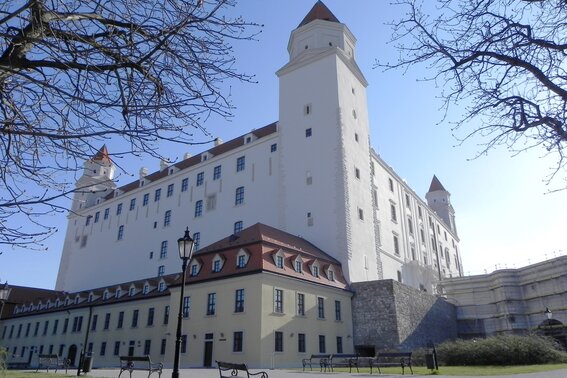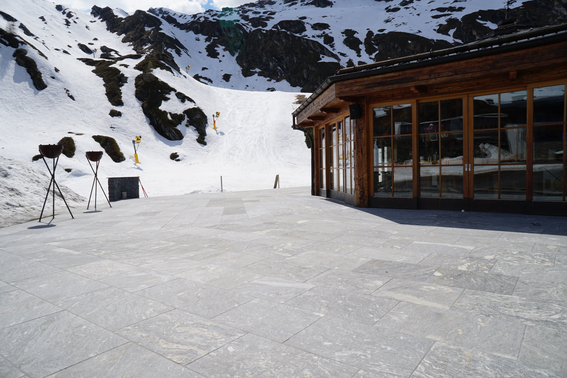Hambach Stately Home: The best prospects for the cradle of democracy
Unity, freedom and democracy: this was what the 30,000 participants of the Hambach Festival in Neustadt an der Weinstrasse demanded in 1832. Hambach Stately Home is still one of the symbols of the German democracy movement in the 19th century, which is why the historical contents of the medieval castle ruins should be preserved as much as possible during the renovation. A new building for the restaurant with a spacious terrace was also constructed – with a spectacular view of the Rhine Valley.
In the mid 19th century, the champions of democracy were attracted to Hambach Stately Home in their droves. In the 20th century, the famous ruin was expanded for educational purposes, and from 2006 it was carefully restored and extended. Almost 180 years after the memorable events, the castle ruins now have a new restaurant building that blends harmoniously into the castle complex.
During the course of renovation, the terrace area also had to be completely renewed, because the visitors have wandered around here on a surface that was both historical and damp to date. The old waterproofing was leaking, and the covering had suffered considerably from the constant moisture, meaning that a new covering was needed.
Historically suitable covering with reliable protection
On the one hand, the new covering was to be consistent with the historical core, and on the other hand robust enough for posterity. The choice was made to use yellow sandstone from the Haard Mountains in the nearby Palatinate Forest. Because this stone has excellent strength values and the yellowish colour went perfectly with the historical buildings. The relevant quarry was in Bad Dürkheim, just 30 km away.
Top marks for AquaDrain T+
The tBU Greven has extensively tested AquaDrain T +. The result: In comparison to the most popular drainage mats for balconies and terraces, this system has the best drainage values – thanks to a drainable cavity of 95%.
Gravel and chippings alone are unsuitable
Having the right substructure was crucial for ensuring that the high-quality covering remains attractive over the long term. Direct loose laying on gravel or chippings was ruled out, because gravel and chippings are not capillary passive. If there is water on the waterproofing at the overlap of the membrane joints, for example, it migrates back upwards via the construction. This results in unsightly moisture stains and weeds in the joints. This is where the Gutjahr AquaDrain T + surface drainage came into play, which was specially developed for the loose laying of natural and artificial stone. The system is capillary passive, and ensures that the covering structure is drained quickly and permanently, even if there is water on the waterproofing in some places.
Well thought-out system
How AquaDrain T + works: The drainage channels form an anti-capillary layer of air. This prevents backwater on the waterproofing from migrating back into the coverings – and therefore damp stains and efflorescence. A test by the tBU Greven also revealed that the Gutjahr system has the best drainage values of all of the most popular drainage mats for balconies and terraces – thanks to the drainable cavity of 95%.
The system also acts as a protective layer and filter layer, and the large contact area of 66% avoids high point loads. An additional protective layer on the waterproofing is therefore not required. A special geotextile fleece with low flow resistance is also laminated onto the plastic film like a filter, which prevents fouling on the waterproofing.
On the terraces and in the inner courtyard of Hambach Stately Home, 16 mm high AquaDrain T + drainage mats were rolled out onto the sealed substrate over a total of about 600 square metres. This was followed by a layer of gravel, onto which the high-quality sandstone could then be laid. The result is impressive: Hambach Castle is not only a figurehead of the democracy movement, but also stands for a successful combination of historical inventory, natural materials and contemporary technology.
About Hambach Stately Home
Built as a retreat for the Speyer bishops in the high Middle Ages, the castle became famous because of the Hambach Festival in 1832. Since then, the castle ruins near Neustadt an der Weinstrasse have been the cradle of German democracy. It was rebuilt between 2006 and 2011 in accordance with plans drawn up by architect Max Dudler. Today, the focus is on the permanent exhibition “Up, up to the castle”. The range of events also includes cabaret programmes, concerts and political forums as well as the new restaurant.
Products used
Similar project reports


![[TRL] Gutjahr Systemtechnik GmbH - Komplettsysteme für den Außen- und Innenbereich](/build/images/gutjahr-logo.d62773db.svg)






